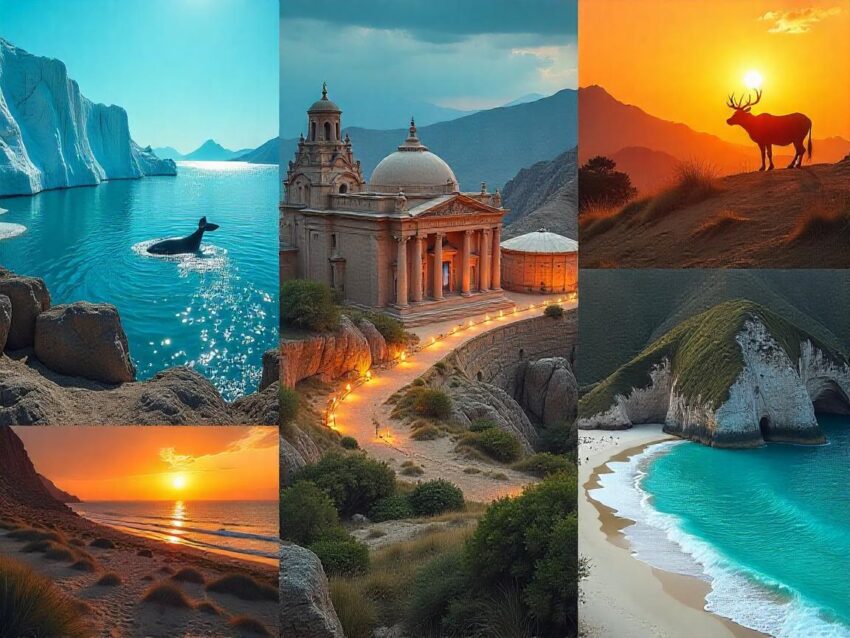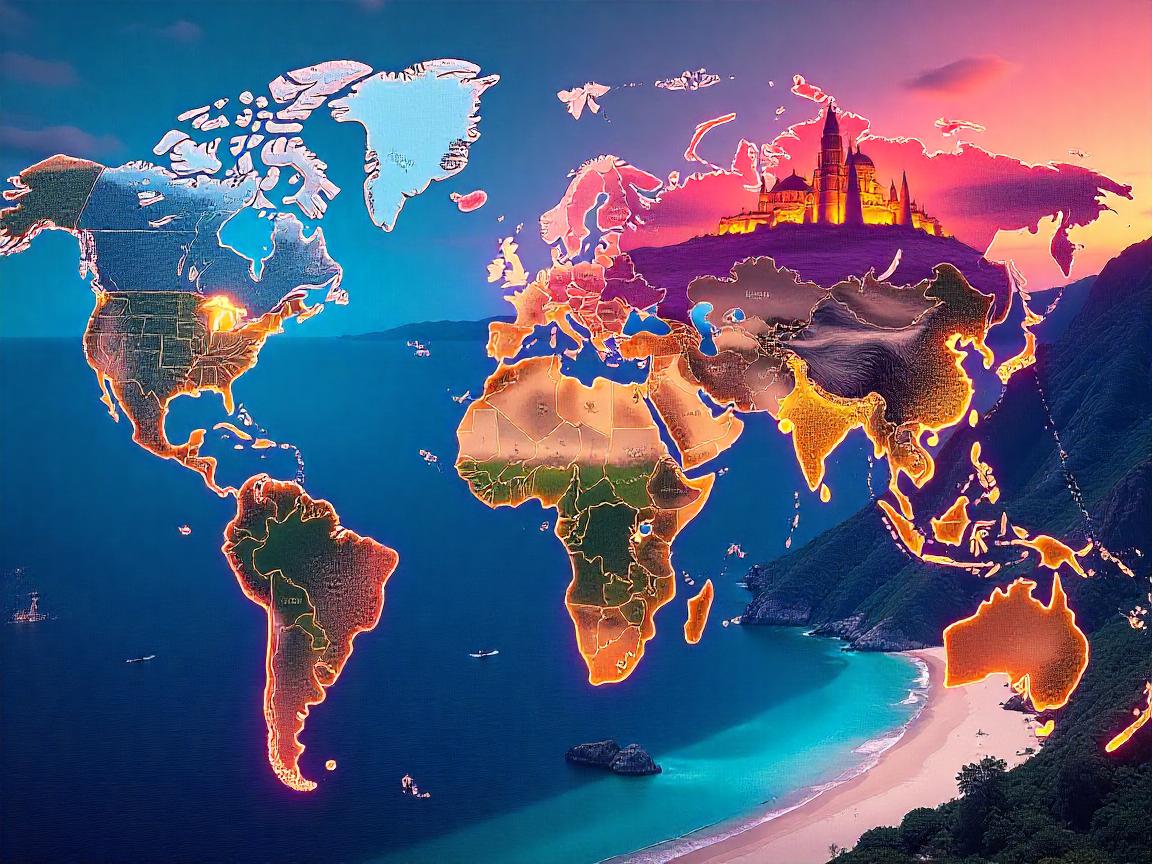Wednesday, July 2, 2025

Now, Greenland joins North Korea, Croatia, Greenland, Philippines, Jordan, and Seychelles in a thrilling global dance of tourism resurgence, each nation fiercely fascinating more tourists than ever before. Meanwhile, the world’s craving for exploration fuels an unstoppable adventure travel surge that’s reshaping flight paths, bucket lists, and entire economies.
However, what’s happening is bigger than you think. Borders that once felt distant or impossible are flinging open. Cultures are stepping onto center stage. Secrets long hidden in icy fjords, ancient deserts, tropical islands, and lush coastlines are bursting into view.
Moreover, Greenland’s icy wilderness, North Korea’s cautious openness, Croatia’s shimmering coast, the Philippines’ powdery sands, Jordan’s mystical ruins, and Seychelles’ paradise shores all whisper one urgent invitation: come now, before the crowds arrive.
Questions swirl. What’s fueling this adventure travel surge? How are these countries preparing for waves of curious visitors?
Hold tight. Because this story is just getting started—and it might change how you see the world.
Greenland has sent out an urgent call to the world: it’s ready for visitors, and it’s eager to share its untamed Arctic beauty.
This colossal island, larger than life and bursting with natural marvels, is entering a tourism era that could change its future forever.
From icy fjords alive with whales to remote villages brimming with Inuit traditions, Greenland promises travelers an experience that feels raw, real, and utterly unforgettable.
New Flight Unlocks Greenland’s Front Door
For decades, reaching Greenland from the United States meant tedious layovers in Iceland or Denmark. But everything changed on June 14 when the very first direct flight soared from Newark, New Jersey, to Nuuk, Greenland’s capital.
This new connection is far more than a flight path—it’s a bridge to a destination poised for transformation.
Meanwhile, tourism experts predict that the direct U.S. link will unleash a wave of adventurous travelers. Americans are increasingly craving sustainable, off-the-beaten-path experiences. Greenland fits that hunger perfectly.
Moreover, the timing couldn’t be better. The global travel industry is roaring back, and Greenland is stepping onto the stage with fierce determination.
A Destination Beyond Political Headlines
Not long ago, Greenland made global headlines for unexpected reasons. A high-profile announcement from the U.S. President about wanting to purchase the territory thrust the island into the spotlight.
However, Greenland’s leaders and people have swiftly reclaimed the narrative.
They want the world to see beyond political theater and focus on what truly makes Greenland extraordinary.
Glaciers shimmering under endless daylight. Vast Arctic landscapes untouched by time. Communities eager to share stories passed down through generations.
It’s a land where ancient traditions breathe alongside modern ambitions. And for travelers, that means a journey both thrilling and deeply authentic.
Tourism Numbers Climb as Curiosity Spikes
Greenland welcomed about 150,000 tourists in 2024—a modest figure compared to many global destinations, but a significant leap for a region with fewer than 60,000 residents.
Now, travel insiders believe those numbers will grow even faster thanks to newfound accessibility and rising global curiosity.
Travelers arriving on the new U.S. flight are diving straight into Greenland’s diverse offerings. Whale-watching excursions leave from Nuuk’s harbors, whisking guests across Arctic waters where majestic creatures breach and spray glistening mist into the sky.
Meanwhile, nature lovers flock to puffin-covered islands, hidden fjords, and dramatic ice formations that look sculpted by an artist’s hand.
Moreover, cultural tours are booming. Visitors crave not just scenery, but a connection to Greenland’s Inuit heritage—a tapestry of resilience, artistry, and deep respect for the land.
Cruise Industry Faces Challenges Amid Local Concerns
Cruise ships already dock at Greenland’s shores, bringing travelers eager for a taste of the Arctic. However, the economic benefit remains complex.
Passengers often sleep and dine aboard their vessels, meaning local businesses see fewer dollars compared to land-based tourists.
Moreover, Greenland’s leaders and residents want tourism to grow at a pace that protects the island’s delicate ecosystem and respects its people.
There’s pride in Greenland’s culture—and a fierce determination that tourism should amplify local voices rather than turn communities into mere attractions.
Locals Champion Sustainable Growth
Greenlanders feel a powerful sense of ownership over how tourism unfolds on their land.
They want to share Greenland’s wonders but insist that visitors see the island through local eyes.
Meanwhile, guides and business owners emphasize storytelling as the heart of every trip. They aim to introduce travelers not just to landscapes, but to Greenland’s soul.
This vision of tourism isn’t about ticking off bucket-list sights. It’s about forging real connections, learning traditions, and preserving an environment that’s both beautiful and fragile.
Moreover, locals are wary of mass tourism’s pitfalls. They want visitors who come with open minds, curiosity, and respect.
Whale Breaches and Unforgettable Moments
For travelers, Greenland is delivering transformative experiences that defy description.
Imagine standing on a boat under a sky lit with midnight sun. Suddenly, a whale breaches from the icy water, sending a spray of ocean droplets sparkling in the Arctic light.
Moments like these turn visitors into lifelong Greenland ambassadors.
Moreover, travelers describe the journey as more than a vacation. It’s an awakening—a reminder that Earth still holds places of true wilderness and raw beauty.
The Balance Between Opportunity and Preservation
Greenland faces an exciting yet delicate balancing act.
Tourism promises economic opportunity for communities seeking sustainable growth. It could bring jobs, income, and a brighter future for many locals.
However, too much, too fast could overwhelm Greenland’s environment, strain resources, and erode cultural integrity.
Meanwhile, leaders are crafting careful strategies. They’re expanding tourism infrastructure in measured steps, training local guides, and building policies that put Greenlanders at the center of the industry’s growth.
This isn’t just about welcoming visitors—it’s about safeguarding what makes Greenland extraordinary.
The Arctic’s Future Tourism Hotspot
As American travelers look north with fresh interest, Greenland stands ready. The direct flight from Newark has thrown open the doors to an island previously reachable only by complicated routes.
Moreover, the world’s appetite for sustainable, meaningful travel has never been stronger. Greenland offers precisely that—a place where adventure and authenticity collide.
However, the coming years will test whether Greenland can protect its culture and landscape while embracing a new era of tourism.
For now, one truth rings out: Greenland is waiting. And the rest of the world has never been more eager to discover its hidden wonders.
A powerful wave of wanderlust is sweeping the globe in 2025. Borders are open, skies are buzzing, and travelers are racing toward new horizons.
From icy fjords in Greenland to Mongolia’s sweeping steppes, countries once considered distant or difficult to reach are rolling out the welcome mat. And it’s transforming the way the world travels.
Travel isn’t just back—it’s surging into new territory.
Greenland: Stepping Into the Arctic Spotlight
Greenland is no longer just a speck on the map for adventurers and scientists.
This colossal Arctic island has leapt onto mainstream travelers’ radars thanks to a game-changing new direct flight from Newark, New Jersey to Nuuk, launched in June 2025.
For the first time ever, American travelers can skip the Iceland or Denmark layovers and head straight into Greenland’s raw, icy wonderland.
Meanwhile, Greenland’s leaders are determined to show visitors more than glaciers. They’re eager to share Inuit culture, storytelling, and everyday life beyond the region’s recent geopolitical headlines.
However, locals remain cautious about mass tourism, determined to protect fragile ecosystems and cultural integrity even as visitor numbers rise.
Mongolia: A Vast Land Opens Wide
Meanwhile, in Central Asia, Mongolia is experiencing a tourism renaissance.
In 2025, Mongolia extended visa-free access to travelers from 34 countries. To top it off, United Airlines launched the first-ever direct flights between the U.S. and Ulaanbaatar this past May.
The result? Mongolia is buzzing with new interest from adventure seekers and cultural travelers alike.
Visitors are eager to ride across endless grasslands, stay in traditional gers, and experience the famed Naadam Festival’s wrestling, archery, and horse racing.
Moreover, Mongolia is pitching itself as an eco-friendly destination, aiming to balance growth with sustainable practices. The nation wants tourism dollars—but not at the cost of its pristine landscapes.
Jordan: Tourism Anchors Economic Vision
Jordan is no stranger to travelers. Petra’s rose-red city and Wadi Rum’s martian landscapes have long lured explorers.
However, Jordan is doubling down on tourism in 2025. A new mutual visa waiver with Russia launched in June, part of Jordan’s strategy to attract diverse global visitors.
Meanwhile, massive investment in Aqaba’s cruise terminal and luxury resorts is reshaping the country’s Red Sea coastline. Jordan aims to compete with Egypt and Israel for regional tourism dollars.
Moreover, Jordan is promoting itself as a safe, welcoming haven in a region often rocked by instability. And that message is resonating, bringing record bookings for fall and winter tours.
Southeast Asia: A Short-Haul Paradise
Across the Pacific, Southeast Asia has roared back as a short-haul favorite, especially for Indian travelers in 2025.
Countries like Thailand, Malaysia, Vietnam, Indonesia, Bhutan, Sri Lanka, and Nepal are aggressively courting tourists. Airlines have slashed fares, hotel rates remain competitive, and visa policies are increasingly traveler-friendly.
Moreover, Southeast Asia continues to position itself as an affordable paradise filled with diverse cultures, beaches, mountains, and spicy cuisine.
However, some destinations are quietly grappling with overtourism and infrastructure strain. Yet tourism boards insist they’re prepared, rolling out sustainable practices and dispersing visitors to lesser-known regions.
Africa: New Horizons and Easier Visas
Meanwhile, Africa is bursting with tourism momentum.
Botswana, Namibia, Zambia, and Zimbabwe have launched a Schengen-style single visa, unlocking seamless multi-country adventures for visitors.
Kenya has also rolled out visa-free entry, positioning itself as a gateway for East African safaris and beach escapes.
Moreover, destinations like Seychelles, Rwanda, and Uganda are marketing exclusive eco-tourism and wildlife experiences, capitalizing on the global hunger for sustainable, meaningful travel.
However, infrastructure and security concerns still challenge certain regions. Nonetheless, Africa’s message is clear: the continent is ready for the world to rediscover its wonders.
Croatia and Istria: Europe’s Rising Star
While Italy and France remain perennial European favorites, Croatia—and particularly Istria—is stealing some of the spotlight in 2025.
This coastal region, once overshadowed by Italy, has become a haven for travelers seeking Roman ruins, vineyards, and less crowded beaches.
Moreover, Croatia’s euro adoption and Schengen-zone entry have streamlined travel, making it easier for American and European tourists alike.
Travelers are swapping Tuscany for Istrian hill towns, discovering that Croatia offers Old World charm at a fraction of Italy’s price tag.
North Korea: A Tiny Crack Opens
Perhaps the most surprising tourism headline of 2025 comes from North Korea.
While the country remains largely closed, it opened the Wonsan Kalma resort to Russian tourists in early July. The rest of the world remains excluded, but it’s a symbolic step signaling Pyongyang’s cautious willingness to dip a toe into tourism diplomacy.
However, experts caution that meaningful mass tourism to North Korea remains years—or decades—away.
Philippines: A Warm Welcome for Indian Travelers
The Philippines took a bold step on July 1 by offering Indian nationals a 14-day visa-free stay.
This move aligns with the Philippines’ strategy to tap into the growing Indian outbound market. Meanwhile, travelers from other countries continue to enjoy simplified entry, making the islands an increasingly attractive beach and diving haven in Southeast Asia.
Moreover, tourism officials are banking on the Philippines’ reputation for hospitality and natural beauty to bring visitors back in droves.
Western Favorites: Always Open, Always Popular
Meanwhile, stalwarts like Italy, Spain, Portugal, Norway, and Japan remain wide open for business. These nations continue to welcome American tourists without visa hassles for trips up to 90 days.
They remain the comfort zones for travelers seeking familiar luxury, culture, and world-class gastronomy.
However, even in these popular spots, travelers are venturing into lesser-known regions, driven by sustainability concerns and the desire for fresh experiences.
A Travel World Transformed
As 2025 unfolds, travelers are spoiled for choice.
New flight routes, shifting visa policies, and a fierce hunger for new experiences are redrawing the tourism map. From Greenland’s glaciers to Mongolia’s steppes, the world feels both bigger and more accessible than ever.
Meanwhile, the tourism industry must navigate sustainability, cultural respect, and geopolitical realities. The challenge is to welcome visitors while preserving what makes each destination unique.
One thing is clear: the spirit of exploration has never burned brighter. The world is open—and waiting.
«Enjoyed this post? Never miss out on future posts by following us»
Tags: Africa, Croatia, global tourism, greenland, Istria, Italy, japan, jordan, mongolia, north korea, norway, Philippines, Portugal, southeast asia, spain, travel industry















